Archive Page 4
February 9th, 2023 by dave dorsey
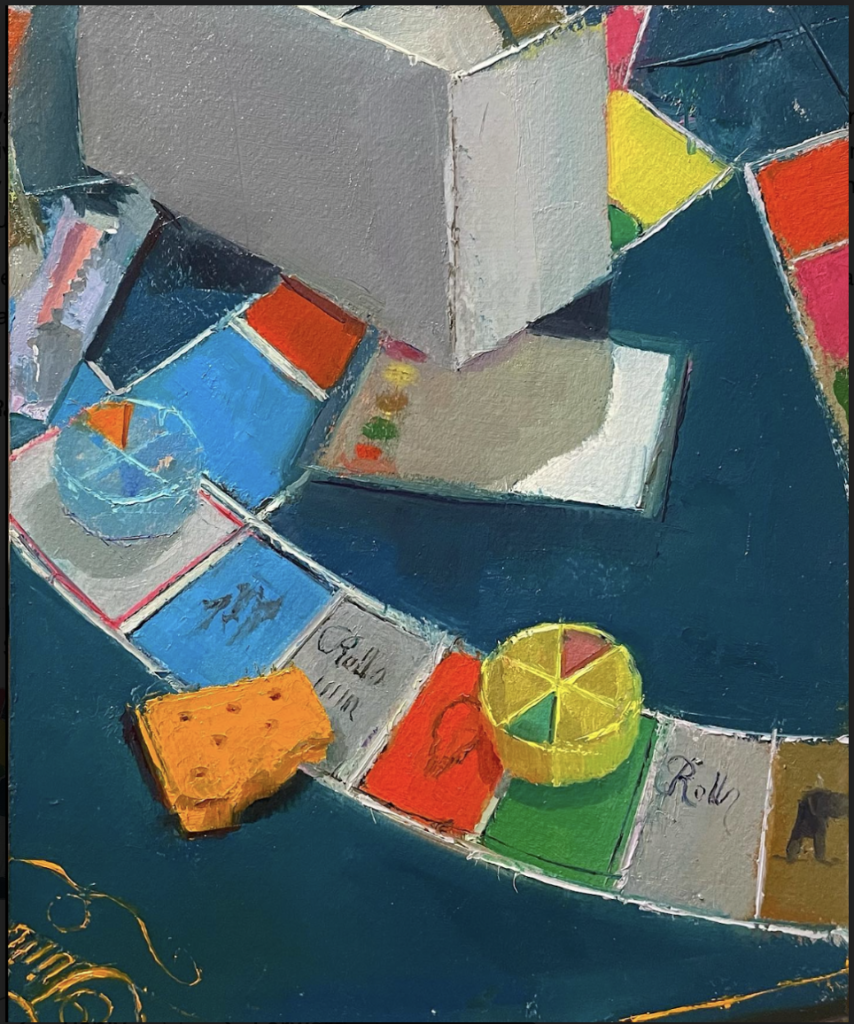
Erin Raedeke, Trivial Pursuit, 10” x 8”, oil on panel.
I’ve been returning to Erin Raedeke’s paintings with pleasure over the past decades. What first intrigued me were her perfectly composed images of what appeared to be detritus from a child’s birthday party. Getting what looked like perfect compositions from a post-party mess was an achievement in itself. Yet her color carried most of the charm. She hasn’t posted any of that uniquely lovely work from a decade ago at her website. I wonder if she thinks they’re too pretty. That’s how Matt Klos referred to them when we were discussing her paintings, after he’d included her work in his curation of a show of perceptual painters in Baltimore. (On my last trip to New York City, Steve Daimant at Arcadia Gallery talked about how he looked for work that was beautiful but not pretty, so pretty is pejorative. Got it. I’ve always thought Matisse cut-outs are pretty great, as well as just pretty, but maybe I’m wrong.)
Some of her more recent still life images come close to those after-party paintings: looking down at a flat surface, objects randomly strewn into view, everything forming an abstract pattern from top to bottom and side to side, with little or no negative space, just a solid patchwork of one thing astride another or sharing adjacent space, everything falling into place randomly as the playmates leave their mess behind. The birthday paintings were haunting, charming, beautiful, with colors perfectly chosen—her sense of color in the best work is extremely good, purely musical—and a little sad, given that we are loitering around after the party has ended, glimpsing the beauty the celebrants left by accident. Go even further back and some of her landscapes from 2006 and 2007 are marvelous village scenes that could be from nearly any little burg or ‘burb in the hilly Northeast. As I’ve written here in a post years ago, Backyard Gardens is a perfect painting, reminding me of the simplified precision of the late Fairfield Porter at his best. My favorite Porters are the ones that I’m certain he did from photographs, keeping his simplified approach to representation, one patch of color next to another, accurate in terms of shape and form but more concerned with light and color than detail, and this painting has that same quality. Her color sense in these outdoor scenes—intensely evocative of a certain kind of light at a given time of day—are quite different from the still life work, but just as carefully felt in the way the colors work together. They aren’t there just to trick the eye or drafted into service as a way of creating a sense of depth or volume or whatever–each color is there for its own sake, along with what it’s doing for the others around it. It’s hard to describe how her color distinguishes itself from so many of her fellow perceptual painters. Her tones, in absolute terms, can be just as muted, but they harmonize and accentuate one another and come together in a way that sometimes sings–not always but often–and has a quality of nostalgic yearning: she feels her images into being with these tones. Her recurrent affinity for humble and common subject matter most painters would think unworthy of attention, often related to childhood—board games, party hats, jelly beans, snacks, Froot Loops turning to junket in a bowl, as Robert Lowell would have put it—it reminds me of Pop’s friendly, unpretentious and anti-heroic attention to everyday things, simple food, household products, things so familiar you don’t even see them when they’re there, inanimate companions everyone takes for granted, domestic objects Chardin might have painted if he’d had a dozen things from the past fifty years shipped back to his era.
You can see Raedeke’s latest work at Exeter Gallery’s current show “Generations.” You can get a preview of the Gen X Series at her site. It’s being shown along with work from Neil Callander and Nicole McCormick Santiago. As Matt Klos writes about the work of all three: “The art in Generations explores youthful memories, present hardships and enjoyments, parenthood, and a look toward the future with soberness and sincerity.” I would say in Raedeke’s work, it’s a mood of poignant joy, a wistful quiet glimpse of innocence, past and yet fully present.
January 27th, 2023 by dave dorsey
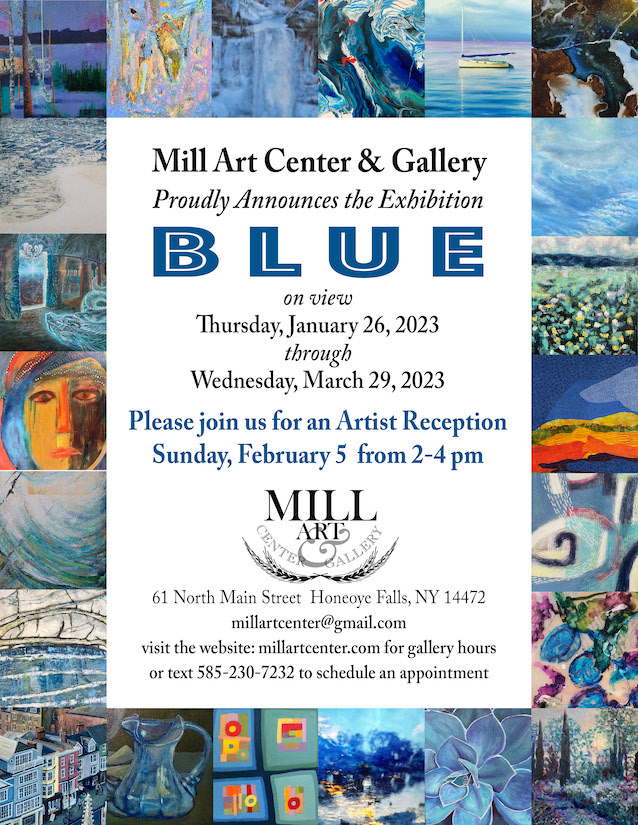
Reception on Feb. 5 for the member’s show at Mill Art Center in Honeoye Falls. My friends Jean and Bill Stephens and many others will be exhibiting work. It’s another great place to find interesting work from regional artists.
January 19th, 2023 by dave dorsey
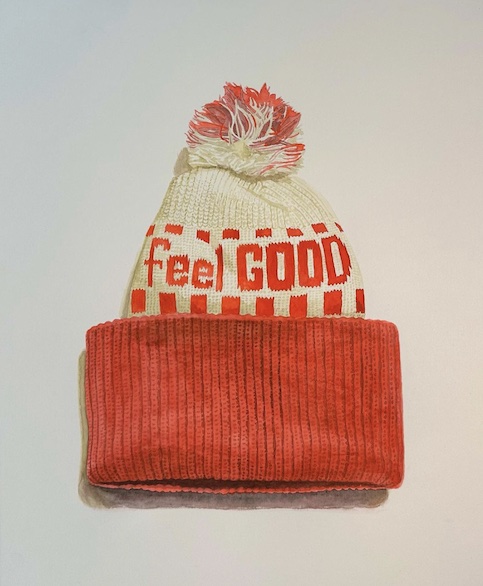
Stocking Cap, Joshua Huyser
Another wonderful painting by Joshua Huyser, from Instagram.
January 16th, 2023 by dave dorsey
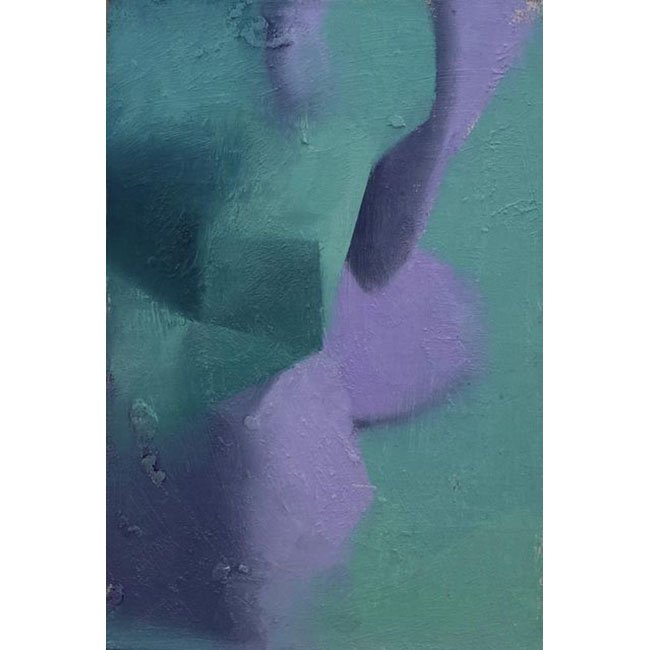
Still Life in Turquoise, Mika Salamon
I’m fascinated by painters associated with the Jerusalem Studio School who are taking perceptual painting in a lush, sensuous direction, with a luxuriant sense of color. I’m loving what they do with limited but rich palettes. Salamon’s work takes that esthetic to an extreme simplicity.
January 13th, 2023 by dave dorsey
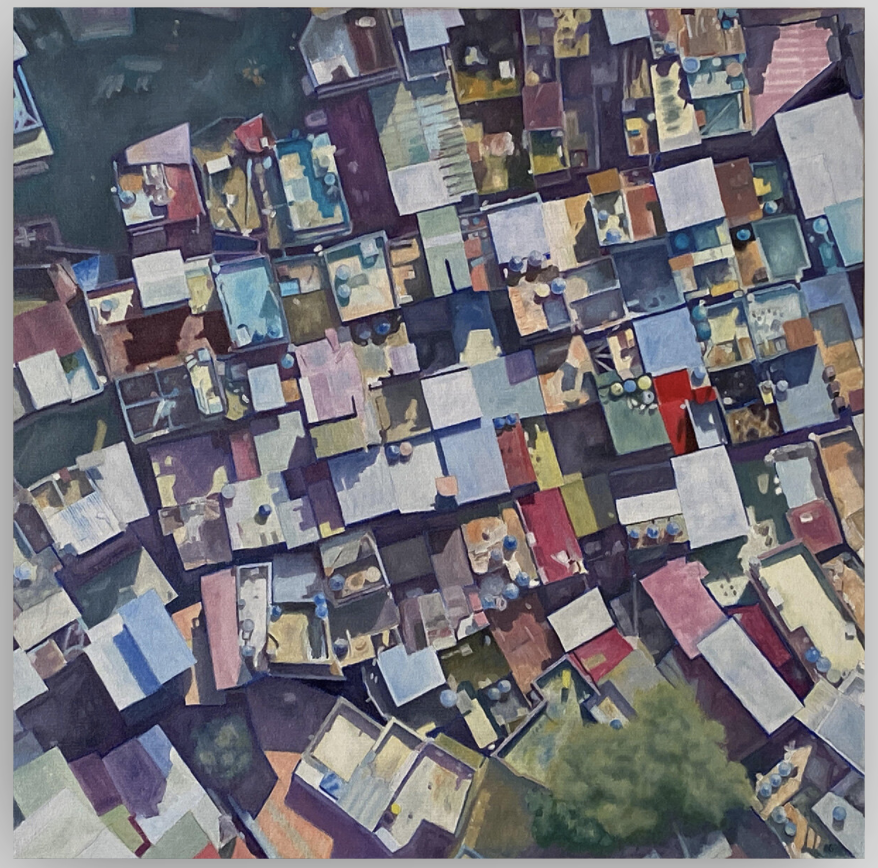
“Rocinha Series 3 No 1”, Alan Garry, 32 x 32, Oil and graphite on canvas
Before I get to my impressions of the juried show currently on view at Viridian Artists, allow me a digression about the location depicted above in one of the exhibition’s paintings.
On a visit to Fiji, my son reported back to me that he found there the poorest and happiest people he’d ever met. I was reminded of that brief report (which included first-person details about indigenous volleyball) when I looked up Rocinha, a famous, densely-populated favela that evolved organically and spontaneously near Rio de Janeiro. It’s occupied by those who can’t afford to live in the more expensive, planned urban areas of the city. It’s a borough scaled for human beings, growing and developing virtually without urban regulation or oversight, with a self-organized, makeshift structure, improvised and wildly colorful. It’s a libertarian’s nightmare that seems to be trying to grow into a libertarian’s dream. The population is packed into tight spaces, structures rarely rising beyond three floors. Nothing looms over anything else there except the upper reaches of the steep hillside on which everything higher up is the same size as everything lower down.
Close to a quarter million people now live in Rocinha, and they get around mostly by foot on a few roads and alleys and paths that snake through the place. As Rio has grown, it has enveloped this encampment that has been crystallizing into a suburban town, now that it’s centrally located. (In a way, the economic mountain came to Mohammad and surrounded him.) It is becoming more modernized so that almost all structures now have plumbing, electricity and sanitation.
From Wikipedia:
Compared to simple shanty towns or slums, Rocinha has a better developed infrastructure and hundreds of businesses such as banks, medicine stores, bus routes, cable television, including locally based channel TV ROC (TV Rocinha), and, at one time, a McDonald’s franchise.[2] These factors help classify Rocinha as a favela bairro, or favela neighborhood.
It’s the urban equivalent of an outlaw entrepreneur, someone more interested in growth than legality. The name Rocinha means “little farm.” This mid-sized city sits on a hillside that has been the backdrop for various productions like Rio and Children of Men. As in Mexico, MORE
January 9th, 2023 by dave dorsey
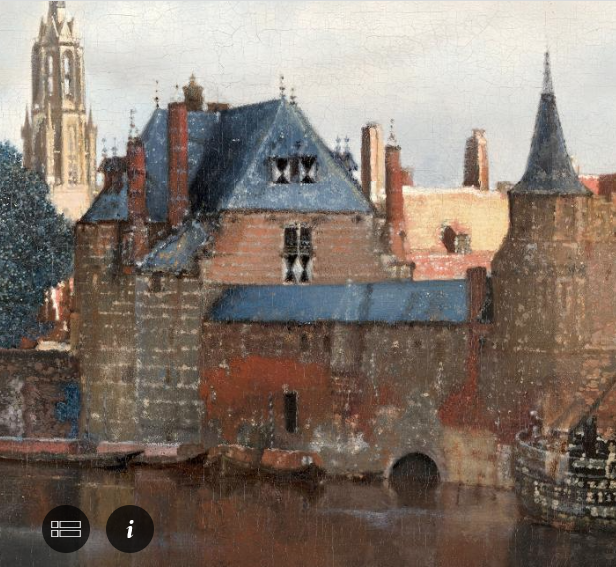
Detail, Vermeer’s View of Delft
The only work of art criticism I return to with relish and as a way of relearning what I already think I understand is In Search of Lost Time. Marcel Proust’s insights into how music, painting and fiction all are grounded in perception, rather than discursive thought, distinguish him from most people who have written about visual art. He understood an artist’s job isn’t to have something to say, so much as the challenge of learning how to see.
In Proust’s novel, on the cusp of death, the novelist Bergotte ventures out unsteadily to an exhibition of Vermeer’s View of Delft. What the fictional writer longs to see one last time is a small, innocuous area of the painting, a simple patch of yellow sunlight on a wall: it’s hardly more than a sensation to his old eyes, with no intellectual substance, no understandable relevance to his life. In that one little detail of Vermeer’s great painting, he recognizes a world of feeling and insight, an intense reality, a meek simplicity in the representation of a commonplace element of human experience that triggers a recognition of his life’s deepest reality. He dies a short time later with regret about having ignored and neglected the quality of this perception, this simple sensation, hidden in plain sight, throughout his entire writing career when his love for it could have been a lodestar for his own writing.
In Search of Lost Time’s narrator is luckier. Marcel has multiple moments quite like this one, and they are more consequential than Bergotte’s. He calls them instances of involuntary memory. They recur throughout the seven-volume novel intermittently until the last book when several in rapid sequence open his heart and finally, after wasting much of his adulthood in social and erotic struggles, he understands how and why to become a writer.
Vermeer’s little patch of yellow was a sort of perceptual synecdoche. In the book, its effect on Bergotte demonstrates the immediate and totalizing impact and power of visual art itself. One snatch of Mozart, or one glance at a Cezanne, and you can behold life’s wholeness, without needing to intellectually dissect what’s been disclosed. It’s immediately recognizable, but was inaccessible until one hears it or sees it. Phenomenologically, as an element of experience, Proust’s serendipitous moments aren’t metaphoric but sacramental in the same way: the fragment is the whole. They don’t signify, they embody. A morsel of experience contains the whole of experience, as in the old New Age holographic paradigm from David Bohm in the 80s, where every part of the world is the whole, in a sense, in a way analogous to the structure of a fractal or a Fibonacci sequence. Proust’s narrator doesn’t theorize about this, he experiences it.
Proust’s awakening is essentially spiritual, through it would be quite easy to construe everything in the novel as merely psychological, an innocuous brain phenomenon mistakenly serving as the fulcrum for a life-changing devotion to what Proust experienced as timeless, imperishable, and Platonic. He never appears to be anything but an observer of the Catholicism in his characters, but he has one passage that implies human beings behave morally because they have intimations, even memories, of a more perfect and eternal state from which they derive their current life. In that passage, he articulates it in Platonic terms: that people remember Goodness because they essentially descend from it when they are born. This is about as far down that road as his narrator goes. Yet the structure of the novel and its pivotal experiences are parallel to traditions in various Axial wisdom traditions: the morning prayer for an Orthodox Christian is to a God who “art everywhere present and fillest all things.” To say the least, this isn’t the state of mind for most people on any given day before heading into work, but it’s analogous to how Proust’s narrator awakens to a new sort of wisdom through otherwise insignificant perceptual experiences. The novelist, in a secular and modernist mode, essentially asserts that the reality of life remains veiled to most of us most of the time, but briefly discloses itself to those who are attentive—and maybe, as it happens in the book, deeply discouraged—enough to be granted these moments of vision, through triggers as humble as the musty smell of a public restroom or the look of a line of trees on the horizon. The whole of life, the ground of life, is there in every experience, every smallest experience: but there’s no way to consciously stand back and behold the whole of things, the musical structure of one’s own experience, the melody your life is essentially composing. You can’t hear it because you are making it. You are it. In these moments of involuntary memory, for Proust, that melody presents itself through humble perceptions.
Proust recognizes the impossibility of seeing the whole, that ground of all things, the unity of all things in any place or time, though some reliable technique. But the “excavation” of art, the descent into one’s own individual experience and perceptions over time, in the act of writing fiction or painting or making music, can open a window in which that reality offers a brief glimpse of itself. That this ought to be an artist’s mission never occurs to Marcel until the end of the story, when he finally sets out to write the book the reader is finishing even though moments of humble illumination, where his life presents itself to the narrator, punctuate the novel and form its central leitmotif.
The question of the relationship of these moments to an artistic vocation runs, like a river underground, throughout Proust’s novel. And the moments when he sees the whole, the entirety of his life, when he recognizes who he is and the beauty of what was there all around him at a particular time, unnoticed—these moments are the underpinning, the foundation of the whole book, both motif and motive. It isn’t the past experience he would like to have remembered that comes back. It’s the entirety of the actual world of his experience that was hidden, inaccessible to his conscious mind, while he was living it. Art isn’t an alternative kind of experience: it is a way of tapping down into the unregarded ground of experience. What is recovered and comes alive is a paradise that is never apparent while most of us are living within it. These moments are the crumbs that lead him out of the sexual and social forest, the illusory pursuit of erotic security and social prestige, in order to create the whole book itself.
These small, quiet moments are the core of Proust’s novel, as Samuel Beckett pointed out in his uncharacteristically eloquent and passionate treatise on the French novelist. For Beckett, the world’s enchantment, its Platonic truth, are out of reach, everywhere present but already pre-lost, as it were, because your awareness is chained to its habitual and learned perceptions and ideas, always returning to what you already know and have already experienced, “like a dog to its vomit.” This, he suggested, is what Proust’s novel depicts in the quality of his unsparing insights into human delusions and cruelties, to guide the reader toward moments that bear intimations of what transcends this suffering: the unattainable awareness of the whole of one’s experience. Art, for Proust, is an attempt to see through the illusions toward this reality, an attempt to wake up. And it doesn’t happen through intellectual or willful means; Vermeer didn’t intend his little patch of yellow wall to inspire a sort of death-bed conversion in a Bergotte. He just worked passionately to get that little bit of sunlight properly rendered in the context of the town’s skyline. Yet the character and skill of the man painting that yellow wall invested it with that perceptual quality, not as something planned or learned, but as a byproduct of years of labor in an attempt to simply capture how things in the world look–and how the finished painting needed to look for it to be properly finished in Vermeer’s eyes. The rest is a gift, for painter and viewer both.
January 6th, 2023 by dave dorsey
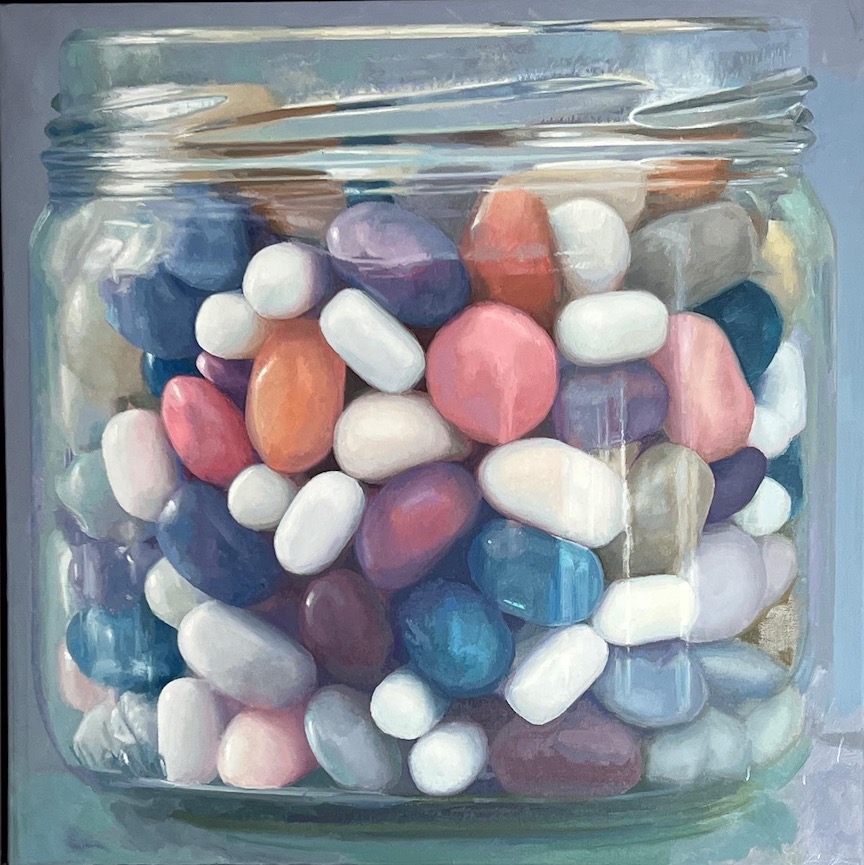
Candy Jar #13, 44×44, oil on linen, 2023
I took a break from taffy in December. It was enjoyable to return to the candy jars, and it’s been long enough that I felt the contrast in doing one of these, a distinctly different flow from the process for painting salt water taffy. The taffy presents a complex topography, a lot of wrinkles, crimps, bends, declivities, a very 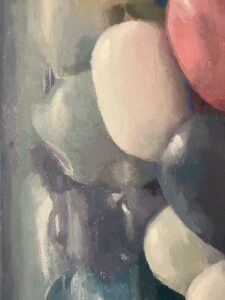 natural terrain–and feels more like portraiture, the candy having a flesh-like consistency and the waxed paper serving as drapery. Hard candy in a round jar, by comparison, feels simple and geometrical, the surfaces so much more readily rendered with flat areas of color and with detail abbreviated by brushwork. I changed the color for many of the pieces–M&Ms, jelly beans and Tic Tacs. What was key lime green became orange while purple shifted to slate blue in places, as I cooled or warmed up the hue on others. Stepping away from the painting it looks photographically precise but, up close, it’s intentionally painterly. This is actually true in some degree with most of the jar paintings. I may try another small series of these this year, but there are so many other things to work on . . .
natural terrain–and feels more like portraiture, the candy having a flesh-like consistency and the waxed paper serving as drapery. Hard candy in a round jar, by comparison, feels simple and geometrical, the surfaces so much more readily rendered with flat areas of color and with detail abbreviated by brushwork. I changed the color for many of the pieces–M&Ms, jelly beans and Tic Tacs. What was key lime green became orange while purple shifted to slate blue in places, as I cooled or warmed up the hue on others. Stepping away from the painting it looks photographically precise but, up close, it’s intentionally painterly. This is actually true in some degree with most of the jar paintings. I may try another small series of these this year, but there are so many other things to work on . . .
January 3rd, 2023 by dave dorsey
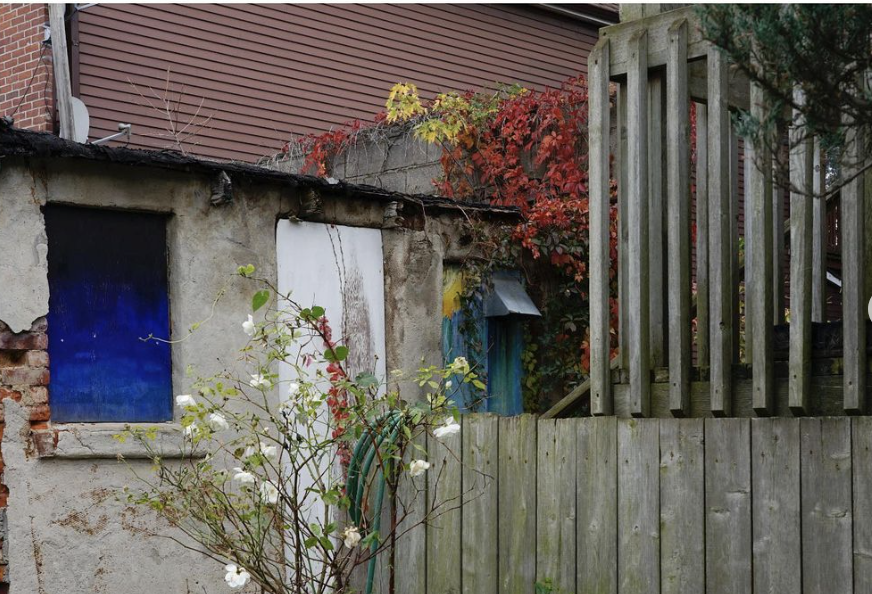
Photography by Dushka Vujovik
This is an unusually lyrical photograph for Dushka Vujovik, whose typical subjects are abstract geometric color compositions created by simply cropping what she sees in her urban environment in Toronto, just a few miles north of us down here on the bottom of Lake Ontario. When she wants to be, as a photographic coloriest, she is a rare bird. Her pallet is restrained–seriously, how much radiant color can one find on the walls of buildings in Toronto or any large city?–but somehow she discovers geometrically arranged fields of beautiful color everywhere around her. In other words she has the core skill of a creative talent: to actually see what’s there rather than what you habitually think is there. She also passes along touches of humor wherever she finds it, and her recent posts have been of the natural world. You can see her marvelous color sense here in this photograph: it’s a quiet little melody with a fine simple drum beat off to the side, courtesy of those fences. You almost can’t lose with Virginia creeper in the mix. As a representationalist obsessed with how to make color central to my work, I’m always impressed by how she achieves that with a camera. Stuart Shils was doing something like this with his camera for quite a while on Instagram. Unlike his current paintings, which are all about color, his photographs found muted abstract compositions in the real; some were black and white. He was great at it, but moved on to the incredible paintings he does now. (It takes a while to scroll down five or six years on his feed to find the photographs, he’s so prolific.) Love Vujovik’s posts. With my limited knowledge of Serbian art, she has to be my favorite Serbian artist after whoever painted the White Angel.
December 30th, 2022 by dave dorsey
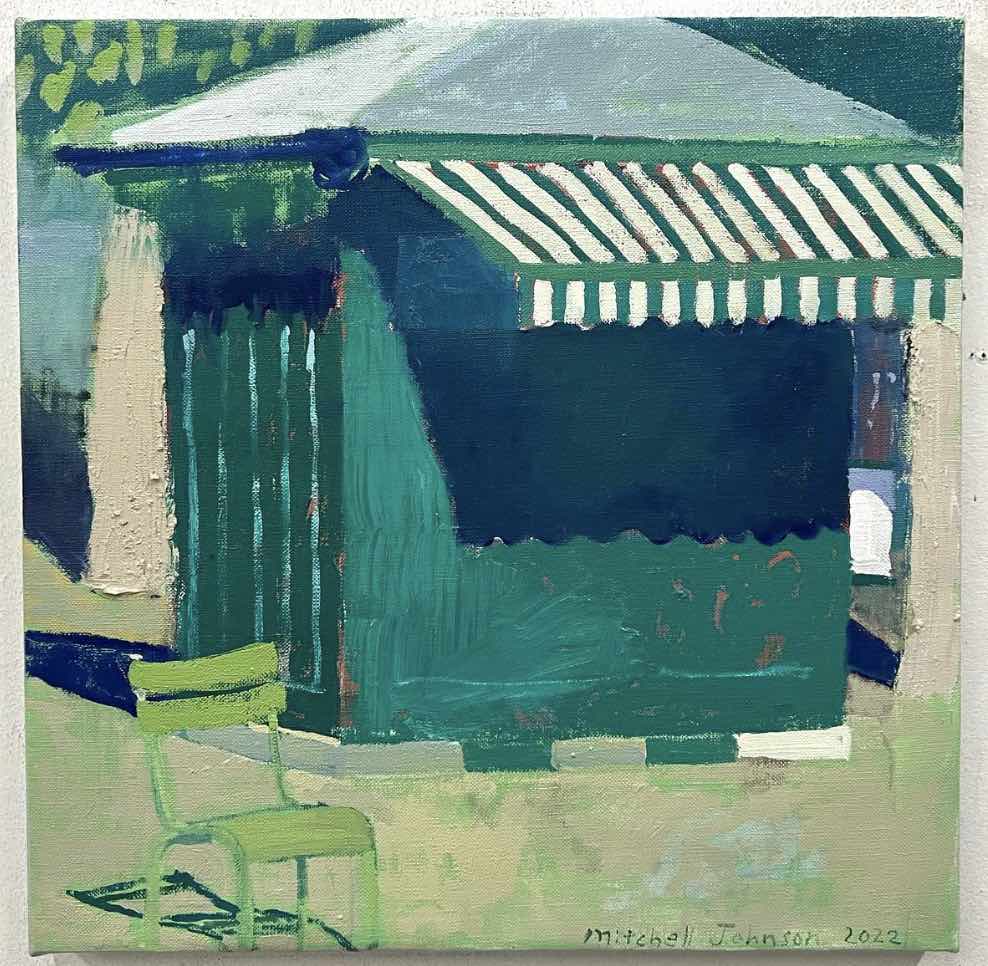
Mitchell Johnson, Luxembourg, 2022, 16×16
December 27th, 2022 by dave dorsey
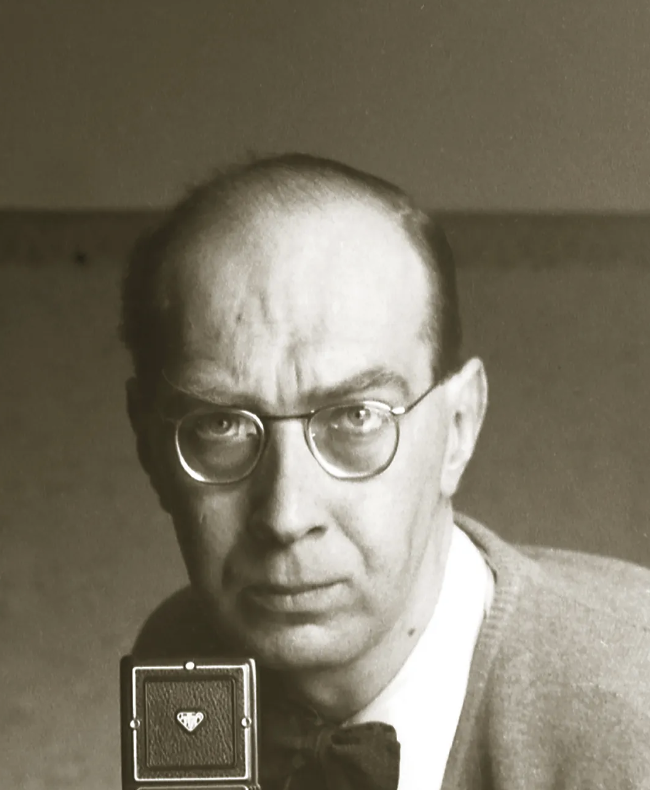
Philip Larkin
I came across this opening to one of Philip Larkin’s essays at random when I spotted the collection on a shelf. He’s admiring John Betjeman for the limpid quality of his poems, their immediacy and accessibility, like the polymath conversational style of early W.H. Auden and James Merrill in The Changing Light at Sandover, a style that conveys an eagerness to be understood and a friendly sense of accessible humanity. He contrasts this kind of simple clarity with the work of T.S. Eliot, though Eliot’s The Journey of the Magi represents exactly the sort of poem Larkin loves:
The scene is worthy of a nineteenth-century narrative painter: The Infant Betjeman Offers His Verses to the Young Eliot. For, leaving aside their respective poetic statures, it was Eliot who gave the modernist poetic movement its charter in the sentence, “Poets in our civilization, as it exists at present, must be difficult.” And it was Betieman who, forty years later, was to bypass the whole light industry of exegesis that had grown up round his fatal phrase, and prove, like Kipling and Housman before him, that a direct relation with the reading public could be established by anyone prepared to be moving and memorable.
It strikes me as a passage that perfectly describes what I like in the work of most painters I love: the immediate sense of being shown something fresh and recognizable at some level, like a melody that instantly starts replaying itself in your brain. Creations that work without the need of interpretation, as Susan Sontag celebrated, because in the way they are painted, the artist conveys qualities equivalent to those conveyed by an individual’s facial expressions, body language, bearing, way of speaking . . . in other words the entirety of a single human wholeness expressed in all the little parts. But the quote also points back to a time when painting didn’t require an instruction manual or a critic to do its work. That time is still now for most painters I love.
December 25th, 2022 by dave dorsey
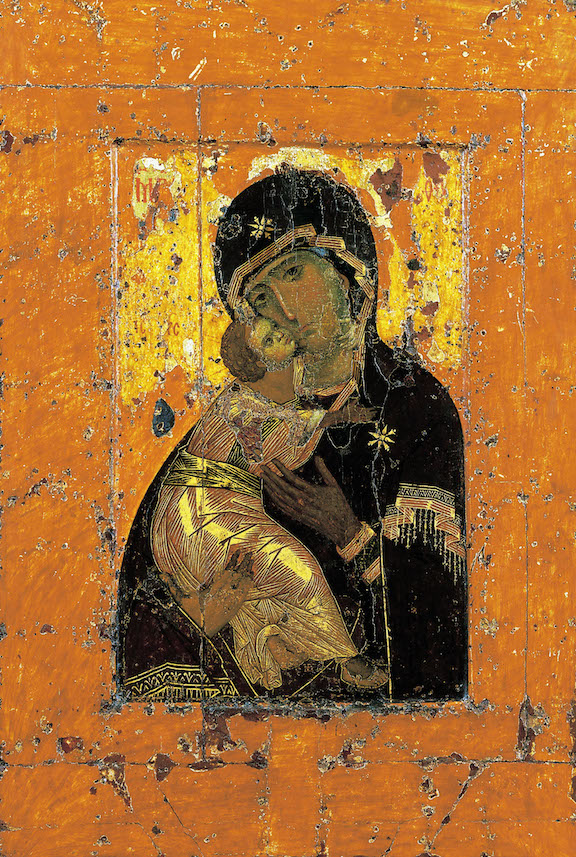
Theotokos of Vladimir, 11-12th century Constantinople, egg tempera, 27 x 41
From the Old Jordanville Prayer Book:
Rejoice, height inaccessible to human thought.
Rejoice, dawn of the mystic day.
Rejoice, rock that refreshes those thirsting for life.
Rejoice, door of solemn mystery.
Rejoice, thou who shows philosophers to be fools.
Rejoice, thou who exposes the learned as irrational.
Rejoice, ray of the noetic Sun.
Rejoice, thou through whom creation is renewed.
–Excerpts from the Akathist to the Theotokos
These lines, in an oblique way, express–in a more ecstatic mode–how I’ve responded to much visual art since my teens. It’s hard to imagine how something in this spirit could be sung as an accompaniment to paintings being made now. Where are the mysterious painters who might evoke this sort of mystical affirmation? Some modernists would have recognized something like this as the mission for painting, Klee and Chagall, even Kandinsky, and many others. Some of the modernist writers as well, Proust and Flaubert (if you look at the arc of his subject matter over his career) and Eliot and Auden.
The Old Jordanville Prayer Book is named after a Russian Orthodox monastery south of Utica, New York, a place I visited in the 80s, a period when I was studying print-making at Munson-Williams-Proctor and writing for the Utica newspapers. When we lived in Utica, I saw a retrospective of Charles Burchfield paintings at the museum that had a deep effect on me, as well as a survey of contemporary representational art that opened up my sense of the possibilities available to me as a painter. When I was assigned a feature story on the Jordanville monastery, the spiritual energy I discovered there astonished me. What most impressed me was how the monks were busy publishing literature to be smuggled into the Soviet Union, before it fell apart, when that country was most repressive, harassing and persecuting its own Orthodox practitioners. Russia maintained tight censorship over religious publications, so the role of producing and distributing books, as samizdat, that Christians wanted within Russia’s borders, fell to a little organization in upstate New York, Holy Trinity Monastery. My visit there bolstered my interest in and respect for Russian Orthodoxy which began in college when I read J.D. Salinger’s Franny and Zooey and then The Way of the Pilgrim, probably the best-known book associated with this church. Now, years later, after having read Everyday Saints–stories about monks in the Soviet Union when the regime was actively hostile to their faith–I found Russian Orthodox services only miles from where I live, in Brighton, NY, at the Protection of the Mother of God. It’s a beautiful place to try and quietly contemplate the ultimate reality of life with people more meek and humble than I am, while being surrounded by paintings on nearly every square inch of wall and ceiling, which seems a particularly appropriate haven for a visual artist to keep an eye on his own spiritual health. One of my good friends at the church, Father Theophan, a Danish monk from Holy Trinity, lives in Brighton–more or less on assignment from Jordanville to assist the church–paints icons, and is also translating the Psalms into Danish from Greek and original versions in other languages. His path began when he read The Way of the Pilgrim around the same age as when I read it–and he likewise became both a painter and writer. At some point, I hope to do a post about him. I’m fascinated by how icon painting is an ongoing and mostly overlooked niche of the art world, continuing without any expectation of economic reward or critical recognition.
I write this post in memory of Peter Shehldahl, The New Yorker’s art critic who confessed to being a non-church-going Christian when he knew he was terminally ill, not long before he died in October. His intelligence and humanity lives on in his writing.
December 21st, 2022 by dave dorsey
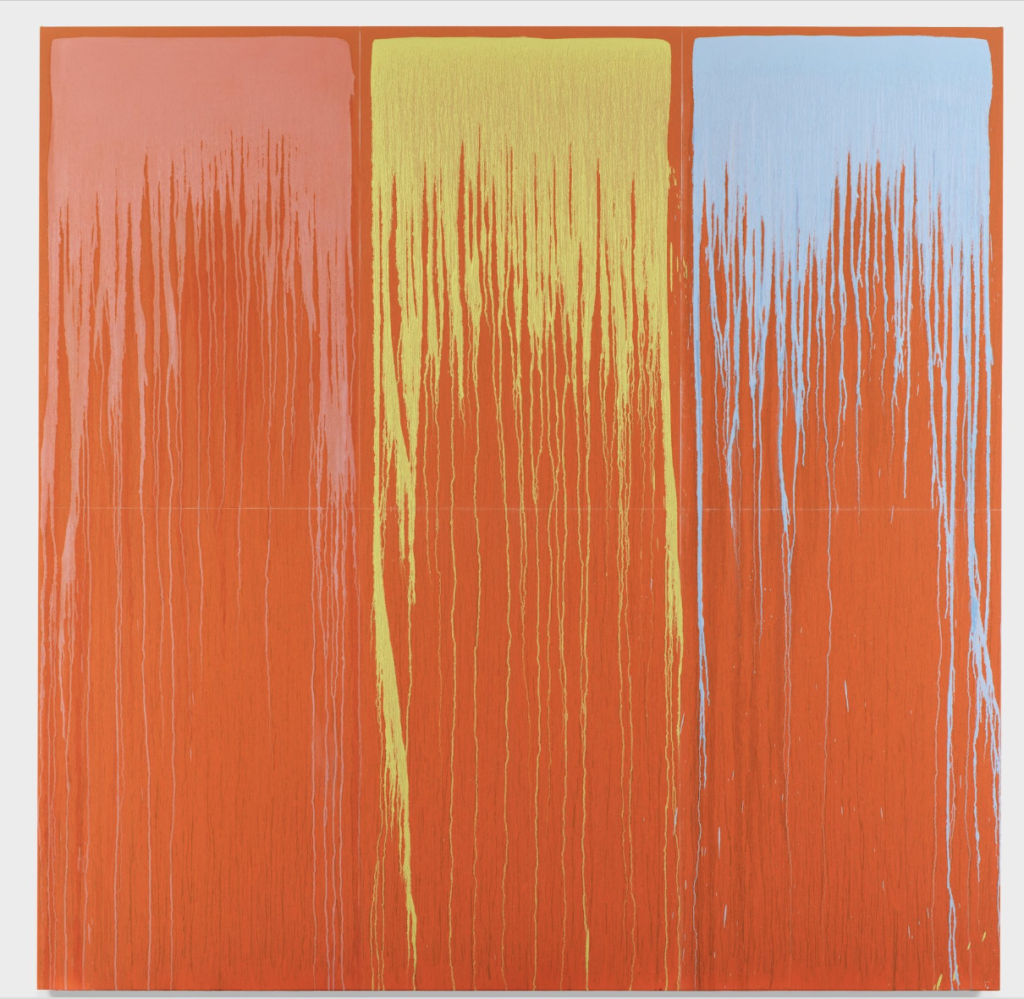
Pat Steir. Rainbow Waterfall #5.oil on canvas, 108 x 108
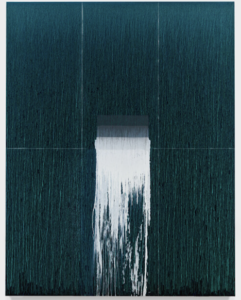 Get to Hauser and Wirth in the next day or two, your last chance to get a glimpse of Pat Steir’s powerfully simplified and radiantly colorful drip paintings, including the largest canvas she’s ever done. She reduces her methods to the most uniform imagery, from painting to painting–working slight variations in color and scale, with an almost Warholesque sense of choosing color schemes within the repetitive armature of an almost identical shape. Chalk lines form a faint grid against which the random journey of the drips sink downward. More to the point, these paintings do what the great color field mimimalists did, severely simplifying the means of making an image and then finding limitless prospects for wildly different states of consciousness as you move from one immersive field of color to the next. The resplendent paintings hum with life. There’s a great review of the show at Hyperallergic.
Get to Hauser and Wirth in the next day or two, your last chance to get a glimpse of Pat Steir’s powerfully simplified and radiantly colorful drip paintings, including the largest canvas she’s ever done. She reduces her methods to the most uniform imagery, from painting to painting–working slight variations in color and scale, with an almost Warholesque sense of choosing color schemes within the repetitive armature of an almost identical shape. Chalk lines form a faint grid against which the random journey of the drips sink downward. More to the point, these paintings do what the great color field mimimalists did, severely simplifying the means of making an image and then finding limitless prospects for wildly different states of consciousness as you move from one immersive field of color to the next. The resplendent paintings hum with life. There’s a great review of the show at Hyperallergic.
December 18th, 2022 by dave dorsey
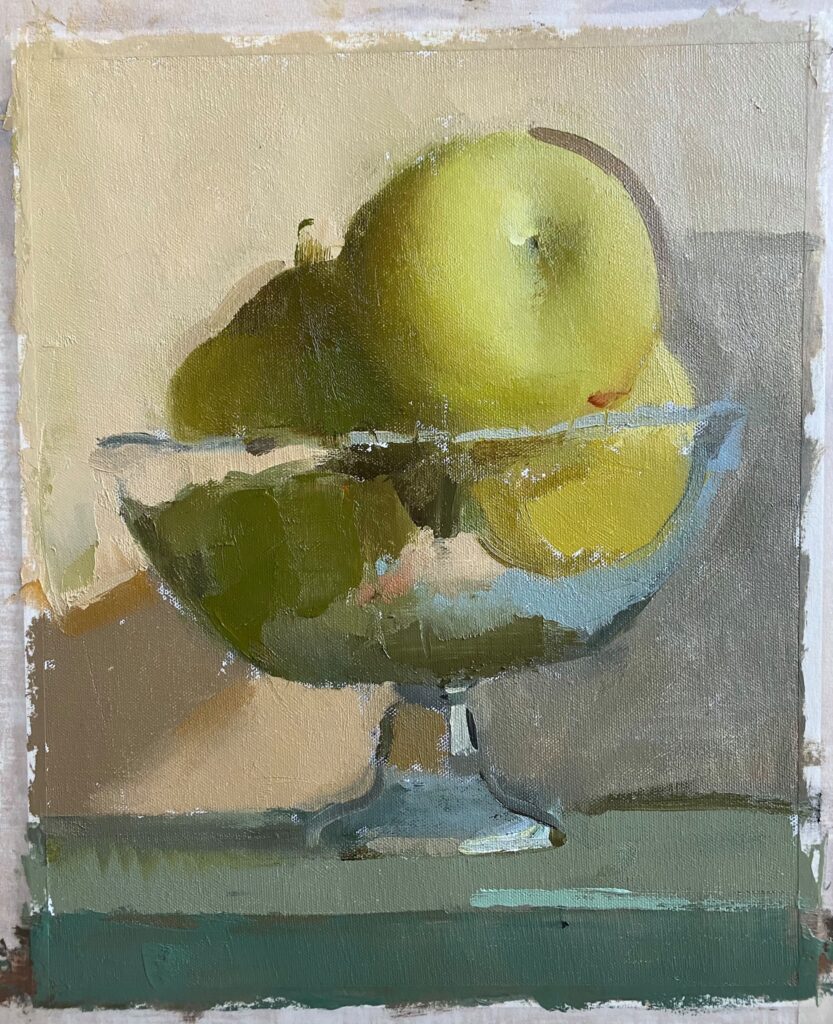
Summer Fruit, Yuval Yosifov, oil on canvas
Only a few days left around the holidays to see this painting (properly stretched and framed in the show) along with work by other painters who studied in Israel in Shapes of Light at the Figure/Ground Gallery in Seattle, a spiritual sister to Sugarlift in Chelsea, where Zoey Frank’s recent work is on view until Jan. 7. Yosifov is young and gifted, someone to watch.
December 15th, 2022 by dave dorsey
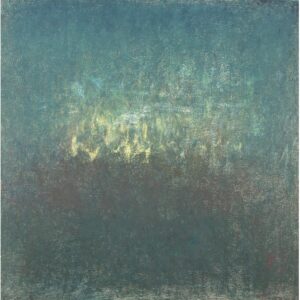
Canopy, Rebecca Purdum, oil on panel, 24″ x 24″
The beauty of her abstractions are Rebecca Purdum’s greatest appeal, bringing to mind both late Monet and Color Field. Yet what delights me the most about her website is the plain-spoken, no-nonsense artist’s statement which is admirably titled: “A few words”:
To start a painting, I look at a surface of infinite possibility. How to find the one image that will be this painting? How to paint something I’ve never seen before? Even after making hundreds of paintings, it is still possible. That anticipation, and its affirmation when a painting is finished, is why I paint abstractly.
Whether a painting is nine feet or sixteen inches, they begin the same way. During the process of painting, however, many factors influence what happens next. Early on, it’s one-sided with my decisions propelling the action. As the surface grows, a shift occurs so that what I want is no longer important. The painting dictates what it needs. I know the painting is finished when what I see has a physical and emotional resonance, unique in time and place. That’s why all the paintings are different.
By contrast, I offer a sample from www.artybollocks.com, the random AI artist statement generator. First results upon clicking the words “generate some bollocks”:
My work explores the relationship between the universality of myth and recycling culture. With influences as diverse as Rousseau and Francis Bacon, new insights are distilled from both mundane and transcendant meanings.
Ever since I was a pre-adolescent I have been fascinated by the essential unreality of the zeitgeist. What starts out as hope soon becomes manipulated into a carnival of defeat, leaving only a sense of nihilism and the unlikelihood of a new synthesis.
As temporal forms become frozen through studious and critical practice, the viewer is left with a clue to the possibilities of our era.
Love that last sentence. At the bottom was a link asking “still not good enough?” Who could resist? I clicked up this:
My work explores the relationship between the Military-Industrial Complex and copycat violence. With influences as diverse as Caravaggio and Joan Mitchell, new insights are created from both orderly and random layers.
Ever since I was a child I have been fascinated by the theoretical limits of relationships. What starts out as yearning soon becomes corroded into a carnival of futility, leaving only a sense of what could have been and the chance of a new order.
As shifting forms become transformed through emergent and critical practice, the viewer is left with a clue to the limits of our world.
With influences as diverse as Monty Python and Woody Allen, the bollocks generator does a nice job of impersonating the average statement, but this carnival of pretention can’t compete with the way Purdum just sticks to the craft and doesn’t try to say what can only be shown. As someone once put it: “What can be said at all can be said clearly, and what we cannot talk about we must pass over in silence.”
December 12th, 2022 by dave dorsey
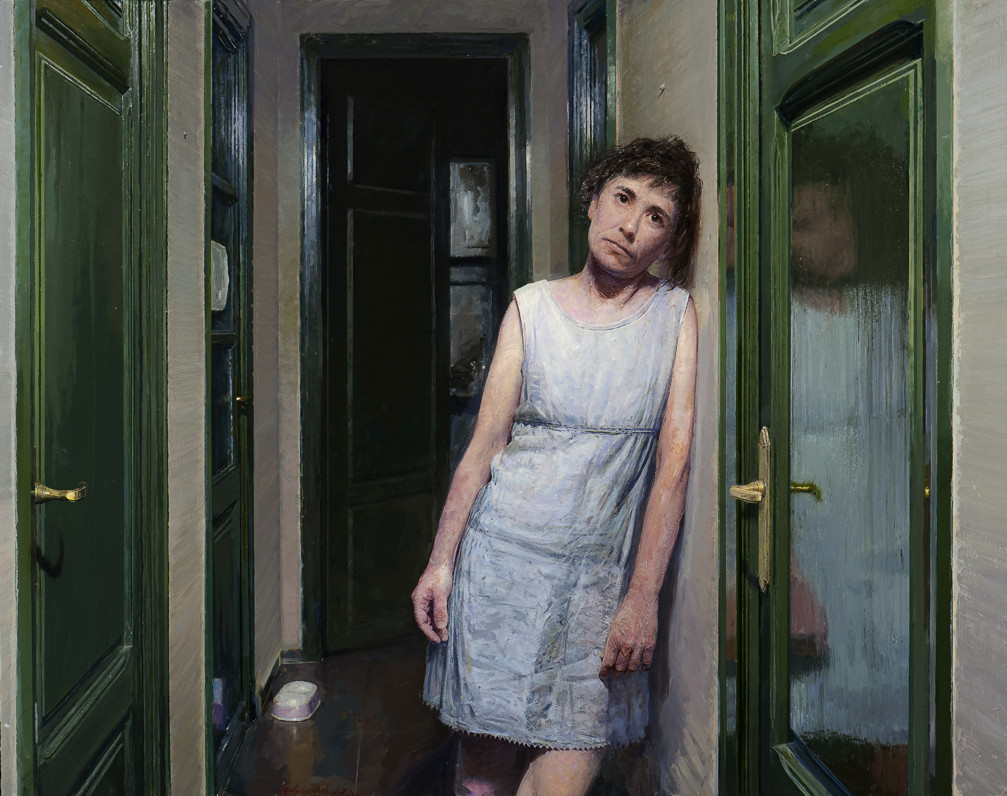
He goes by a single name, like Madonna or Bono or Sting, the contemporary Spanish master, Golucho, completely self-taught and mostly under-the-radar if you try to learn more about him on-line. One finds little written about him, but he’s considered part of the New Realism, with Antonia Lopez Garcia in the forefront of the movement. His work is less astringent that Garcia’s, more willing to use unnatural tones of color to evoke a response that moves the viewer beyond one’s initial amazement over his boldly persuasive technique. It’s easier to think of Garcia as a photo-realist, though Golucho likely is working at least partly from photographs of his subjects. His use of color varies from restrained to lush, from beautiful to assertive, and his drawings of aged bodies seem to descend from the Northern Renaissance yet don’t look coldly clinical. Occasionally he emerges from his information embargo to teach briefly and then withdraw: once at the New York Academy of Art in 2009 and then with a group of Chinese students who came to Spain in 2017 for a week of instruction hosted by the International Arts and Culture Group based in Florence, Italy.
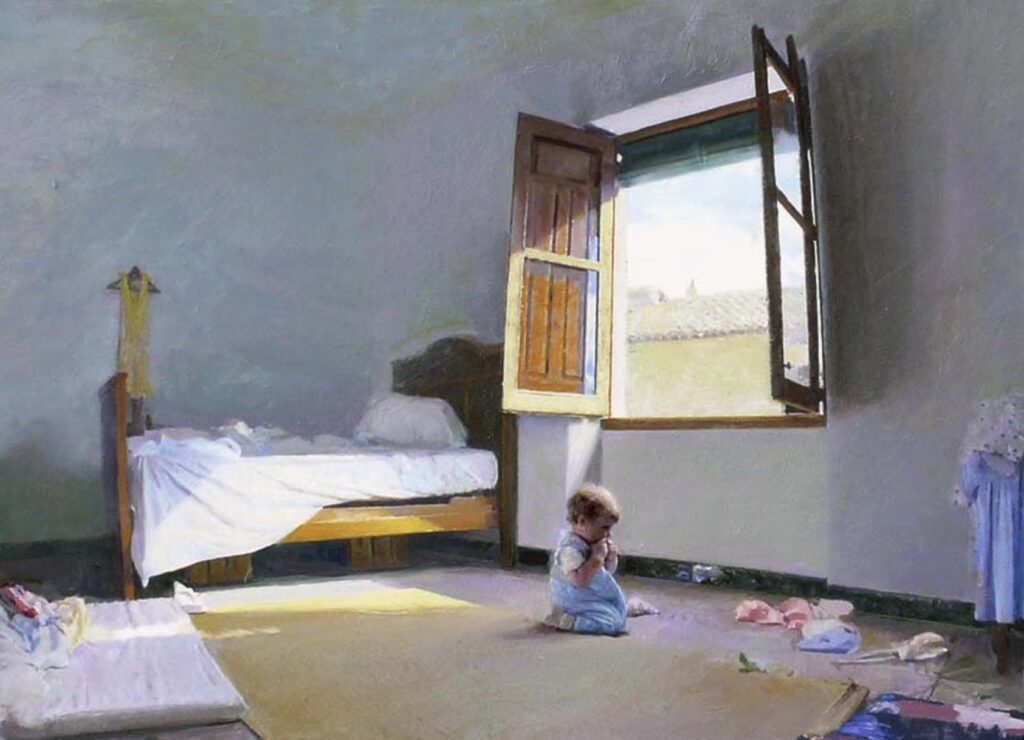 His figures and still lifes are frequently lit from overhead, and both are startlingly vivid with brushwork that seems to be almost Tonalist, layer upon layer over surfaces he scores and scratches. His mastery reminds me of Jerome Witkin but his brushwork is less bravura, and his compositions are simplified and often almost vacant except for a human figure and a few indications of a room with random furniture: figures that look as if they are on a stage in the middle of a Beckett play. His few translated comments are more profound than most artist statements. In one he sounds like Hemingway on the art of writing: “The best part of painting is what hasn’t been painted.” One could take that enigmatic pronouncement a number of ways, syntactically: what’s left out as a result of the artist’s skill, what’s yet to be done by future painters, what remains to be done to a given painting but is yet to appear. A longer comment aims at the heart of painting, the quality no amount of art criticism can pin down or reliably identify:
His figures and still lifes are frequently lit from overhead, and both are startlingly vivid with brushwork that seems to be almost Tonalist, layer upon layer over surfaces he scores and scratches. His mastery reminds me of Jerome Witkin but his brushwork is less bravura, and his compositions are simplified and often almost vacant except for a human figure and a few indications of a room with random furniture: figures that look as if they are on a stage in the middle of a Beckett play. His few translated comments are more profound than most artist statements. In one he sounds like Hemingway on the art of writing: “The best part of painting is what hasn’t been painted.” One could take that enigmatic pronouncement a number of ways, syntactically: what’s left out as a result of the artist’s skill, what’s yet to be done by future painters, what remains to be done to a given painting but is yet to appear. A longer comment aims at the heart of painting, the quality no amount of art criticism can pin down or reliably identify:
The problem with realism is that everyone believes that they understand it, they think before a realistic picture that its aim is the mere representation of everyday life. On the other hand, abstraction makes the viewer become humble and say ‘I don’t understand it’ and in that way, by not discovering that picture, they’re closer to the testimony of that work, but when it comes to quickly ‘understanding’ the painting, there is realism. The conclusion is that the viewer stays on the surface of what is represented and this work can be left in mere appearance and in technical ability.
What he appears to mean is that critical attention can focus on nothing but appearance and technical skill. What many might understand from these words would be: it’s easier to understand what greets you visually with a realist painting, it’s recognizable and that’s a great part of the pleasure, but simply transcribing the look of things isn’t the point. Abstraction can be puzzling and therefore brings the viewer closer to the actual mystery of painting, the way appearances point toward something less visible (something that isn’t intellectual content). But privileging abstraction pushes aside what feels like easily understood realism as a lesser form of painting, mere copying. What he’s likely saying is that “understanding” isn’t the point. The point is to see what’s being shown through what’s depicted, and that remains mysterious but the actual aim of the painter. You behold something you can’t carry away as knowledge. It isn’t available to intellectual analysis or description. To engage with it, you have to keep looking.
December 9th, 2022 by dave dorsey
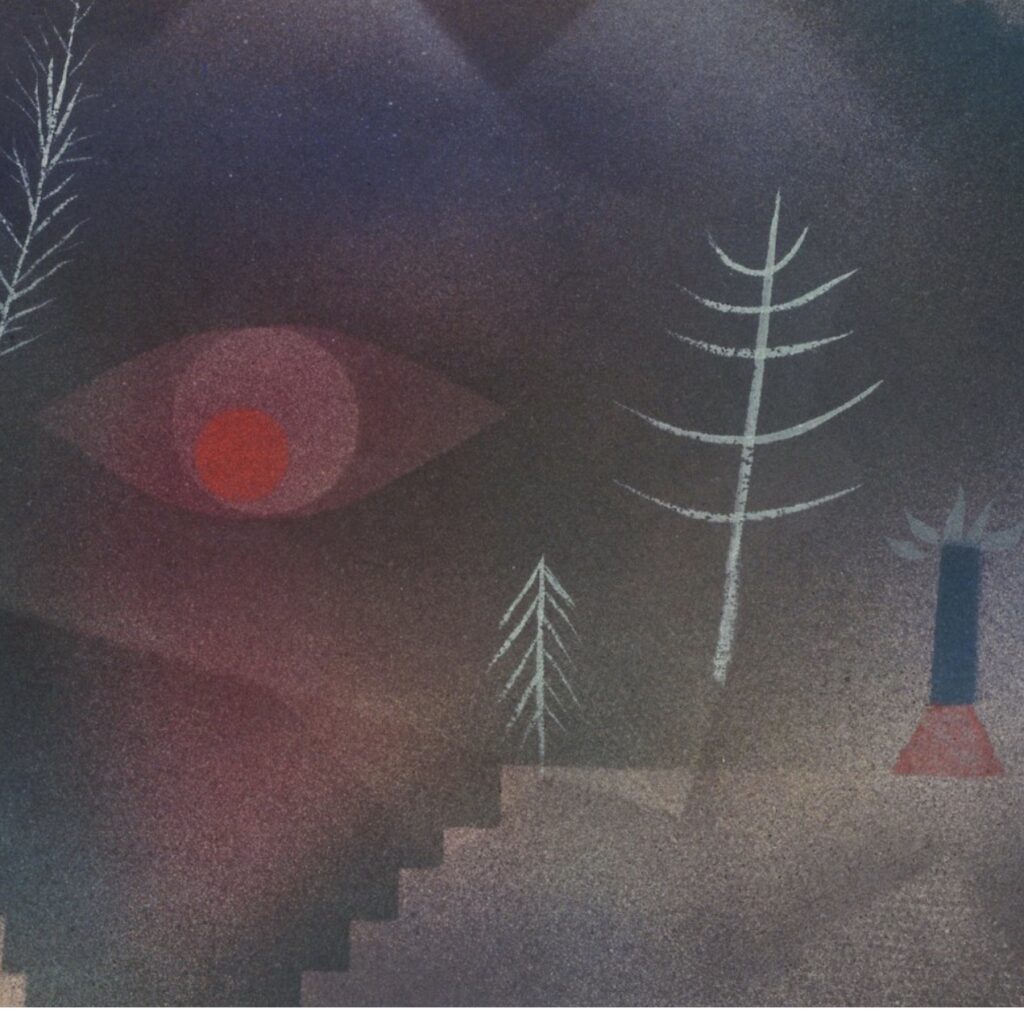
This month in the New York Review of Books, Jed Perl wrote what’s almost a seminal essay on the way contemporary artists are finding their place in the spectrum that runs from pure abstraction to pure representation. For his argument, he reduces the spectrum to a polarity. He wants artists to pick a side and stick to it: be abstract or representational and work within the lines dictated by that choice. Instead, dogs and cats are living together, and he doesn’t like it. By lamenting the loss of the trench warfare between abstraction and realism, he aims at the central challenge for an individual painter now, but doesn’t quite articulate it. It’s a wonderfully thoughtful and well-written assessment that nearly nails the universal quandary painters face now—but he doesn’t quite enable the reader to see his target. He zeroes in on it and then veers away like a pilot who notices his runway is occupied at the last minute.
Anarchy is axiomatic now: anything goes, and everything is contemporary. A small part of what’s produced deserves celebration, as is true of most human endeavors. But anything is possible because everything is permitted. This is pretty much the open field painters face. They choose their own rules, with or without the attendant philosophical justification for one’s métier that Arthur Danto requires each artist to keep handy, like a holstered sidearm hanging from the easel. Perl yearns for the old faiths, the face-off between abstraction and realism that carried forward from early modernism through the 60s and into the 70s when the cheerful ironies of Pop Art and color field minimalism and then photorealism seemed to overshadow the intellectual angst that gave AbEx such gravitas and made New York City the center of the global art world. But then, poof, the antinomies withdrew, and we have the slow-motion free-for-all of individual invention, our current scene. Oh, the humanity.
It puts us in a place where snobbery still prevails, everyone is welcome to look down on anyone outside a particular zone of taste, and justify the sneer with commentary on what matters in painting. As if what matters can be put into words. Everything has splintered and the splinters keep splintering until we have Donald Kuspit’s advocacy of neo-Old Masters pursuing idiosyncratic visions, which screens out the enormous and wonderful fecundity of what’s going on everywhere. Anyone who tries to say what ought to be privileged in art criticism is missing what’s most vital and unpredictable in both art and life. The good stuff is always surprising. Critics make plans; God and artists laugh.
What runs counter to Perl’s vision is the much broader sense among many painters that they ought to do work that answers to the demands of both abstraction and representation. There’s a loose spiritual confederation of perceptual painters who want to fuse representation and abstraction in a way that makes much of their work appear to belong to a consistent, new school of painting. From where I sit, perceptual painting is a much broader category. It’s any painting that achieves what it sets out to do without intellectual baggage, without the homework, without any conceptual foundation or fixed rules whatsoever: what you see is where it’s at, not what you or even the painter thinks the painting is up to. The thinking lags behind, like a high school girl trying to make the word “fetch” happen in Mean Girls. MORE
December 6th, 2022 by dave dorsey
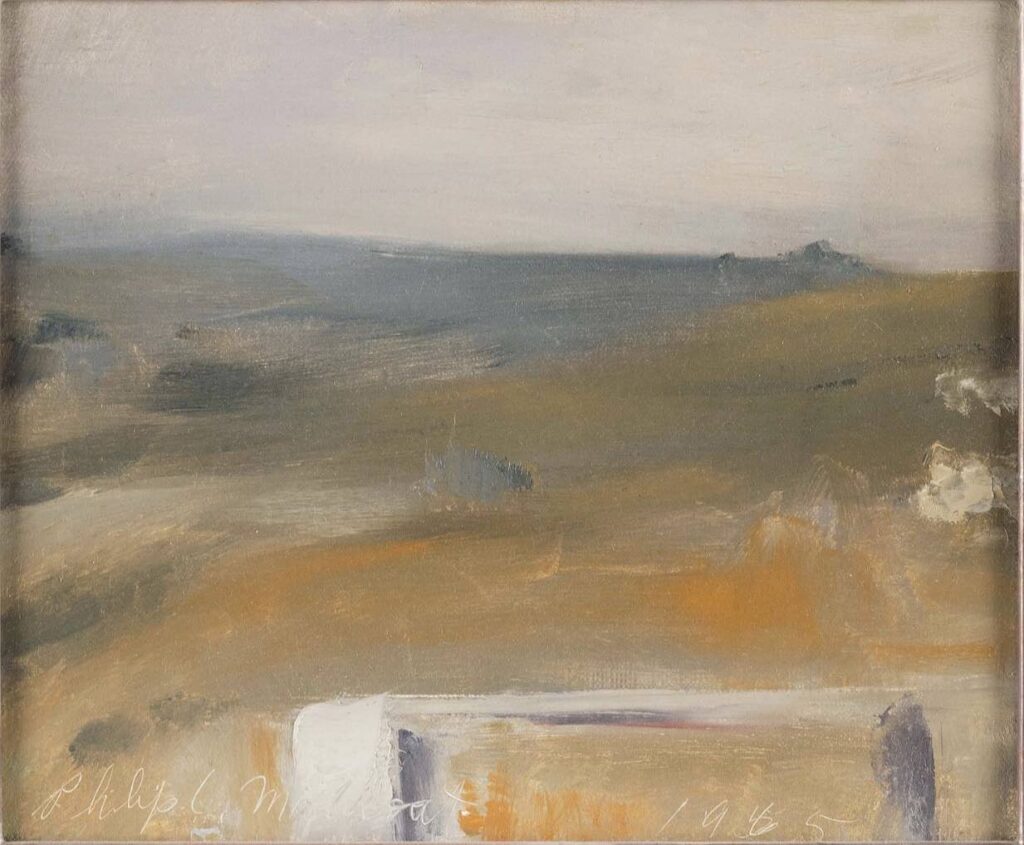
Back Shore, Philip Malicoat, 16″ x 22″, oil on canvas.
Tom Insalaco told me earlier this year to check out Philip Malicoat. His close association with Edwin Dickinson emerges immediately in one glance at his work, in both modes that Dickinson employed: the large, dark and mysterious figures and interiors and the quickly executed, nearly abstract scenes Dickinson described as “first stroke”: premier coup. Back Shore is clearly an example of the latter. From the Provincetown Art Association and Museum:
Philip Cecil Malicoat was a child of farmers with little exposure to the arts, first in Oklahoma, then in Indiana, before coming to Provincetown in 1929 to study with Charles Hawthorne. Malicoat went on to build a life in Provincetown, meeting his wife, the artist Barbara Haven Brown, and together raising two children, Martha and Conrad, both of whom became accomplished artists. Malicoat was active in Provincetown arts community as a member of the Provincetown Art Association and Beachcomber’s Club, a teacher, a painter, and, in 1968, a co-founder of the Fine Arts Work Center.
December 3rd, 2022 by dave dorsey

Jessica Brilli, Morning of the Camping Trip, acrylic and oil on canvas, 30″ x 30″
This new painting, from earlier this year, has the amazing quality Jessica Brilli often achieves with her vintage cars. The forms are utterly flat and abstracted, a geometric puzzle, and yet her handling of values makes the trunk of the car jut into view. That effect is supported by the one area of analog gradation from dark to light on the wall of the garage behind the car. The colors viewed individually are flat and muted, almost dull–that blue sky looks lusterless in a disciplined way, but arrange them in relation to one another the way she has and what comes to life is the heat and light and expectant silence of a summer morning, just before a longed-for getaway. The canoe is a wonderful touch, also given a sense of three-dimensional depth with the smooth shift in values along its curve. The whole painting comes alive around those two red tail lights, like a pair of opossum’s eyes, their little U-shaped highlights underneath the crimson irises echoing the slim arch of shine over the rear window. The car looks sentient but fast asleep, eyes wide shut, waiting. The restraint of the subtle hues, and the combination of uncommon tones, the rigor of her reduction of everything to the simplest possible terms, everything works inexplicably to create the aura of an eerie moment both commonplace and alluringly mysterious, everything charged with somnolent but vigilant awareness.
November 30th, 2022 by dave dorsey
A painter’s impossible challenge, as well as the essence of painting, from The Little Prince.
And now here is my secret, a very simple secret: it is only with the heart that one can see rightly, what is essential is invisible to the eye.
–Antoine de Saint-Exupery
“The narrator becomes an aircraft pilot, and one day, his plane crashes in the Sahara desert, far from civilization. The narrator has an eight-day supply of water and must fix his aeroplane. Here, he is greeted unexpectedly by a young boy nicknamed “the little prince.” The prince has golden hair, a loveable laugh, and will repeat questions until they are answered.
The prince asks the narrator to draw a sheep. The narrator first shows him the picture of the elephant inside the snake, which, to the narrator’s surprise, the prince interprets correctly. After three failed attempts at drawing a sheep, the frustrated narrator draws a simple crate, claiming the sheep is inside. The prince exclaims that this was exactly the drawing he wanted.”
November 27th, 2022 by dave dorsey
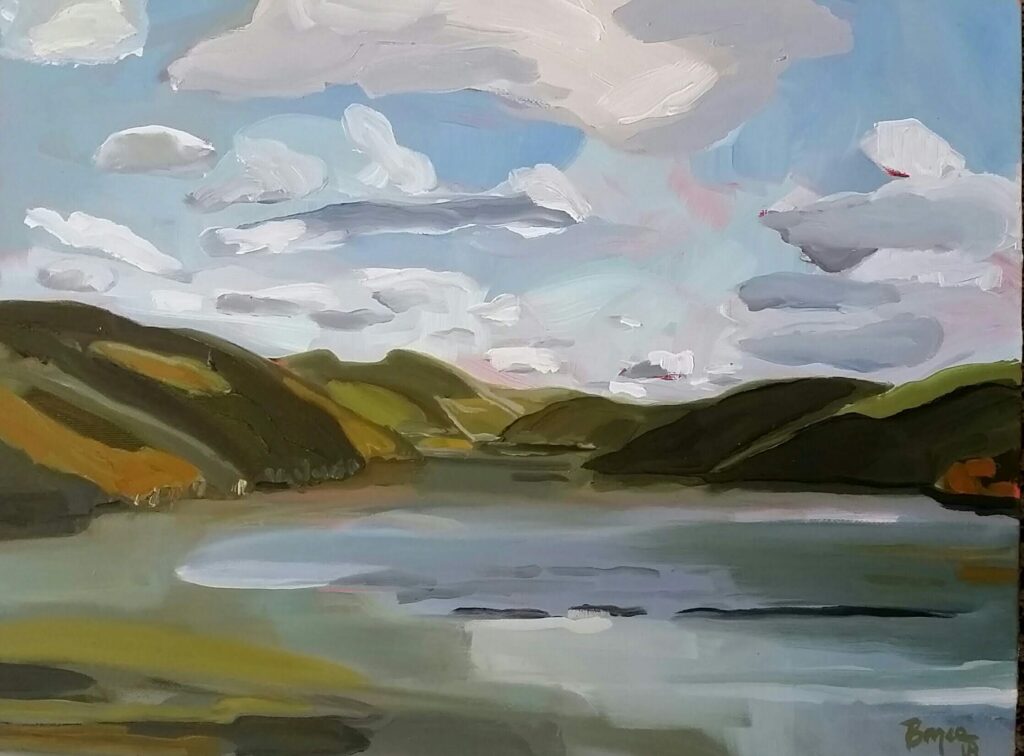
Phyllis Bryce Ely, Seneca Lake, Looking South, oil on linen, 12 x 16, 2019.
Phyllis Bryce Ely has been doing en plein air paintings of the nearby Finger Lakes, one of which is on view in Spellbound: The Art of Mystery at Oxford Gallery. I keep coming back to this image she sent me, at my request, a while ago. It’s less abstracted than much of her work, and more reliant on the shape of the brush and the flow of the paint for the cool tension between the accuracy of the paint and what I’m seeing through it. What I love is how loose and yet carefully precise it is. This isn’t really bravura brushwork, it’s more personal than that: it has her touch, the ghostly, translucent gradations between tones. Much of what Ely does is less like what one would actually see standing at a scenic pull-off, more like the Group of Seven or at least Lauren Harris, but Ely’s work is even more about the paint. This one creates a very real and precise sense of a three-dimensional view and yet looks utterly free and spontaneous in the way she applies the paint.







 natural terrain–and feels more like portraiture, the candy having a flesh-like consistency and the waxed paper serving as drapery. Hard candy in a round jar, by comparison, feels simple and geometrical, the surfaces so much more readily rendered with flat areas of color and with detail abbreviated by brushwork. I changed the color for many of the pieces–M&Ms, jelly beans and Tic Tacs. What was key lime green became orange while purple shifted to slate blue in places, as I cooled or warmed up the hue on others. Stepping away from the painting it looks photographically precise but, up close, it’s intentionally painterly. This is actually true in some degree with most of the
natural terrain–and feels more like portraiture, the candy having a flesh-like consistency and the waxed paper serving as drapery. Hard candy in a round jar, by comparison, feels simple and geometrical, the surfaces so much more readily rendered with flat areas of color and with detail abbreviated by brushwork. I changed the color for many of the pieces–M&Ms, jelly beans and Tic Tacs. What was key lime green became orange while purple shifted to slate blue in places, as I cooled or warmed up the hue on others. Stepping away from the painting it looks photographically precise but, up close, it’s intentionally painterly. This is actually true in some degree with most of the 




 Get to Hauser and Wirth in the next day or two, your last chance to get a glimpse of Pat Steir’s powerfully simplified and radiantly colorful drip paintings, including the largest canvas she’s ever done. She reduces her methods to the most uniform imagery, from painting to painting–working slight variations in color and scale, with an almost Warholesque sense of choosing color schemes within the repetitive armature of an almost identical shape. Chalk lines form a faint grid against which the random journey of the drips sink downward. More to the point, these paintings do what the great color field mimimalists did, severely simplifying the means of making an image and then finding limitless prospects for wildly different states of consciousness as you move from one immersive field of color to the next. The resplendent paintings hum with life. There’s a great review of the show at
Get to Hauser and Wirth in the next day or two, your last chance to get a glimpse of Pat Steir’s powerfully simplified and radiantly colorful drip paintings, including the largest canvas she’s ever done. She reduces her methods to the most uniform imagery, from painting to painting–working slight variations in color and scale, with an almost Warholesque sense of choosing color schemes within the repetitive armature of an almost identical shape. Chalk lines form a faint grid against which the random journey of the drips sink downward. More to the point, these paintings do what the great color field mimimalists did, severely simplifying the means of making an image and then finding limitless prospects for wildly different states of consciousness as you move from one immersive field of color to the next. The resplendent paintings hum with life. There’s a great review of the show at 


 His figures and still lifes are frequently lit from overhead, and both are startlingly vivid with brushwork that seems to be almost Tonalist, layer upon layer over surfaces he scores and scratches. His mastery reminds me of Jerome Witkin but his brushwork is less bravura, and his compositions are simplified and often almost vacant except for a human figure and a few indications of a room with random furniture: figures that look as if they are on a stage in the middle of a Beckett play. His few translated comments are more profound than most artist statements. In one he sounds like Hemingway on the art of writing: “The best part of painting is what hasn’t been painted.” One could take that enigmatic pronouncement a number of ways, syntactically: what’s left out as a result of the artist’s skill, what’s yet to be done by future painters, what remains to be done to a given painting but is yet to appear. A longer comment aims at the heart of painting, the quality no amount of art criticism can pin down or reliably identify:
His figures and still lifes are frequently lit from overhead, and both are startlingly vivid with brushwork that seems to be almost Tonalist, layer upon layer over surfaces he scores and scratches. His mastery reminds me of Jerome Witkin but his brushwork is less bravura, and his compositions are simplified and often almost vacant except for a human figure and a few indications of a room with random furniture: figures that look as if they are on a stage in the middle of a Beckett play. His few translated comments are more profound than most artist statements. In one he sounds like Hemingway on the art of writing: “The best part of painting is what hasn’t been painted.” One could take that enigmatic pronouncement a number of ways, syntactically: what’s left out as a result of the artist’s skill, what’s yet to be done by future painters, what remains to be done to a given painting but is yet to appear. A longer comment aims at the heart of painting, the quality no amount of art criticism can pin down or reliably identify:


